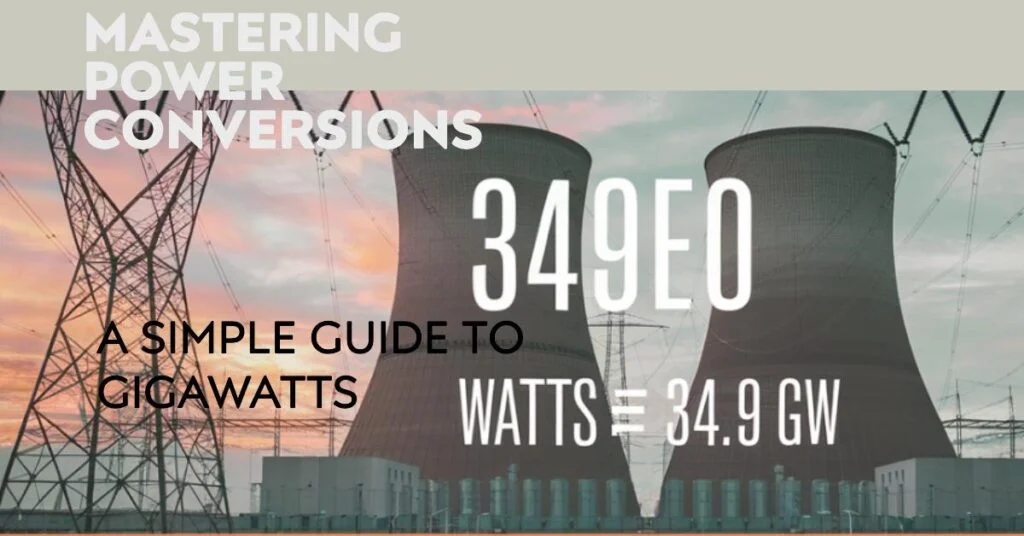In the realm of energy, understanding the magnitude of power outputs can be mind-boggling. Whether you’re an engineering student, a professional in the field, or someone with a curiosity about how our world is powered, encountering large numbers—like 3.49e10 watts—can be daunting. This post aims to demystify the process of converting such a colossal figure into gigawatts, offering a straightforward conversion formula alongside relatable examples. By the end of this article, you’ll not only have a grasp of the conversion but also an appreciation of the vastness of energy we harness daily.
Understanding the Basics of Power Measurement
Power measurement forms the backbone of physics and engineering, underpinning countless applications from household appliances to massive power stations. At its core, power refers to the rate at which energy is consumed or generated. The standard unit of power is the watt, named after James Watt, an influential figure in the development of the steam engine.
One watt is relatively small, representing a joule per second. At this scale, watts are suitable for describing the power consumption of small devices. However, when addressing larger systems like cities or countries, we turn to more extensive units such as kilowatts (1,000 watts), megawatts (1,000,000 watts), and gigawatts (1,000,000,000 watts). This progression highlights the staggering scale of power our society requires and generates.
Understanding these units is crucial for anyone involved in energy production or consumption. From engineers designing power plants to policymakers setting energy regulations, the proper application of power units ensures accuracy and efficiency in energy-related endeavors.
Breaking Down the Conversion Formula
The conversion from watts to gigawatts may seem complex, but it’s a straightforward arithmetic calculation once you understand the relationship between these units. The formula is as follows:
To convert watts into gigawatts, you divide the number of watts by one billion. This formula simplifies the process, allowing for quick conversions without requiring advanced mathematical skills. It’s an essential tool for professionals who need to work with large numbers daily.
This conversion is not just applicable in theoretical scenarios. In real-world contexts, such as reporting the energy output of a power plant or the electricity consumption of a city, understanding how to convert watts to gigawatts ensures clarity and precision. These conversions are crucial for transparent communication in industries where power dynamics play a pivotal role.
Why We Use Scientific Notation
The expression “3.49e10” represents 3.49 times ten raised to the tenth power, or 34,900,000,000. This use of scientific notation is common in scientific and engineering contexts, where dealing with exceedingly large or small numbers is routine. It streamlines communication, reducing the potential for errors when managing numerous zeros.
3.49e10 Watts to Gigawatts Scientific notation is not just a convenience; it is a necessity. In fields like astronomy, physics, and engineering, the ability to succinctly express large magnitudes is vital. This practice allows professionals to focus on the essence of their work without getting bogged down by cumbersome numerical representations.
For students and newcomers, understanding scientific notation can open doors to deeper comprehension of scientific literature and data. Mastering this notation can significantly enhance one’s ability to engage with complex scientific concepts.
Converting 3.49e10 Watts to Gigawatts
Now, let’s apply the conversion formula to 3.49e10 watts. By dividing 34,900,000,000 watts by 1,000,000,000, we find the equivalent in gigawatts:
\[ Gigawatts = \frac{34,900,000,000}{1,000,000,000} = 34.9 \]
Thus, 3.49e10 watts is equivalent to 34.9 gigawatts. This conversion illustrates the sheer magnitude of power represented by such a large number. It underscores the vast energy requirements inherent in modern society.
Understanding this conversion is critical for anyone working in fields related to energy. For engineers designing turbines, analysts estimating energy consumption, or educators teaching physics, the ability to convert between power units facilitates effective communication and understanding.
This conversion also serves as a reminder of the scale at which energy operates in contemporary life. From powering entire cities to supporting critical infrastructure, gigawatt-level energy needs highlight the importance of efficient power generation and distribution.
Real-World Examples of Gigawatt Usage
To appreciate the significance of 34.9 gigawatts, consider some real-world applications where such power levels are either used or generated. For instance, the average nuclear power plant produces about one gigawatt of electricity. Thus, 34.9 gigawatts could equate to the combined output of approximately 35 nuclear plants.
In another context, the annual electricity consumption of a medium-sized country lies in the range of tens to hundreds of gigawatts. For example, New Zealand’s electricity demand is around 40 gigawatts annually. Thus, 34.9 gigawatts represents a substantial portion of a nation’s power needs, illustrating how significant this conversion is.
These examples underscore the critical role that gigawatt-level power plays in sustaining modern life. From supporting industrial processes to providing electricity for homes and businesses, the ability to generate and manage such power is foundational to societal progress.
The Importance of Accurate Energy Conversion
Accurate energy conversion is indispensable for multiple reasons. Firstly, it ensures precise communication of power statistics, whether in technical reports, news articles, or governmental policies. Misinterpretations or errors in conversion can lead to costly consequences, ranging from financial losses to safety hazards.
Secondly, accurate conversions aid in planning and implementation of energy projects. For engineers designing power plants or grid systems, knowing the correct power output in gigawatts influences design decisions and ensures that projects meet the required specifications.
Finally, accurate energy conversion supports sustainable development. By understanding the power needs of various regions and sectors, policymakers can make informed decisions regarding renewable energy investments, reducing reliance on fossil fuels.
Tools for Power Conversion
Several tools are available to assist with power conversion, ranging from online calculators to specialized software. These tools can handle complex calculations, reducing the risk of human error and saving time for professionals. They are invaluable for engineers, scientists, and educators who need to convert power units frequently.
Online calculators, in particular, are convenient for quick conversions without needing extensive computational resources. Many websites offer free tools that allow users to input values and receive instant results, facilitating seamless integration into daily tasks.
For more intricate analyses, dedicated software solutions provide enhanced capabilities. These programs cater to those requiring sophisticated calculations, such as power system designers or energy analysts. By leveraging these tools, professionals can streamline their workflows and improve accuracy.
Common Mistakes and How to Avoid Them
While converting power units is relatively straightforward, common mistakes can occur. One frequent error involves misplacing the decimal point, which can drastically alter the conversion result. To avoid this, always double-check calculations and confirm the placement of zeros.
Another mistake involves confusing units, such as switching between kilowatts, megawatts, and gigawatts. Maintaining a consistent unit framework throughout a project helps prevent such errors. It is beneficial to label units clearly in calculations and documentation.
Using tools and software can also help mitigate mistakes. These resources often include safeguards or error-checking features that alert users to potential issues, ensuring accuracy and reliability in conversions.
Exploring the Future of Power Generation
The future of power generation is set to evolve dramatically, driven by technological advances and increasing demand for clean energy. Gigawatt-level projects, such as large-scale solar farms and wind power installations, are at the forefront of this transition.
These renewable projects exemplify the shift towards sustainable energy sources. By harnessing natural resources like sunlight and wind, such initiatives reduce carbon emissions and contribute to environmental preservation. This evolution towards gigawatt-scale renewable energy is crucial for mitigating climate change.
The development of smart grids also plays a role in the future of power generation. These systems enable more efficient distribution and consumption of electricity, reducing waste and optimizing energy use. By integrating AI and IoT technologies, smart grids enhance the reliability and sustainability of power networks.
Challenges in Meeting Gigawatt-Level Energy Needs
Meeting gigawatt-level energy needs presents several challenges. One significant issue is the intermittency of renewable energy sources. Solar and wind power, while abundant, are subject to fluctuations in availability due to weather conditions, necessitating robust energy storage solutions.
Another challenge is the integration of new technologies into existing power systems. Retrofitting infrastructure to accommodate renewable energy sources can be both costly and complex. Governments and industry leaders must collaborate to develop strategies that facilitate a seamless transition.
Balancing energy demand with environmental considerations is also a critical challenge. Increasing energy production must align with sustainable practices to minimize ecological impact. Prioritizing green energy solutions and investing in research and development are essential to overcoming these challenges.
The Role of Education in Power Conversion
Education plays a pivotal role in advancing knowledge and proficiency in power conversion. By fostering an understanding of energy fundamentals, educational institutions prepare the next generation of engineers, scientists, and policymakers.
Curricula should emphasize practical application, equipping students with the skills to apply theoretical concepts to real-world scenarios. Incorporating hands-on projects, internships, and partnerships with industry leaders enhances learning outcomes and bridges the gap between academia and industry.
Continued professional development for current practitioners is also vital. Workshops, seminars, and certification programs offer opportunities for lifelong learning, ensuring that professionals remain adept in the latest power conversion techniques.
Conclusion
From understanding the basics of power measurement to applying conversion formulas, mastering the transition from watts to gigawatts is essential for anyone involved in the energy sector. By comprehending the magnitude of 3.49e10 watts, we gain insight into the tremendous power demands of modern society.
Accurate energy conversion is foundational for efficient communication, informed decision-making, and sustainable development. With the tools and knowledge outlined in this guide, you are well-equipped to tackle the challenges and opportunities presented by gigawatt-level energy needs.
For those eager to explore further, resources such as online calculators, industry publications, and educational programs provide avenues to deepen your expertise. By engaging with these resources, you can contribute to the ongoing transformation of our global energy landscape.







Leave a Reply